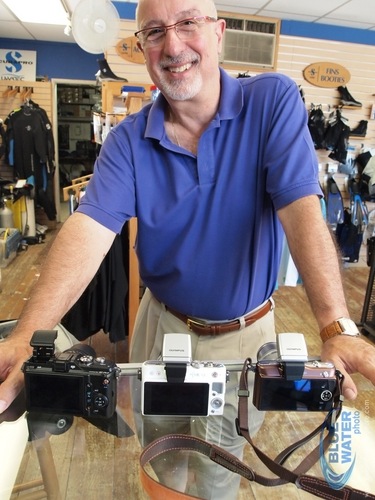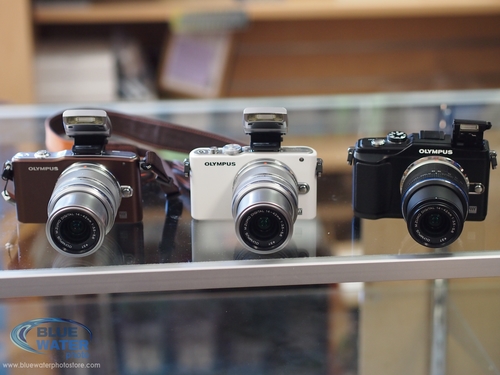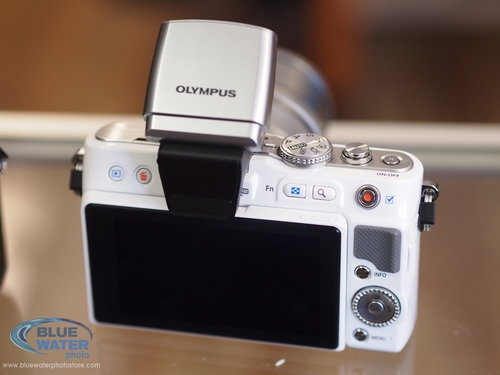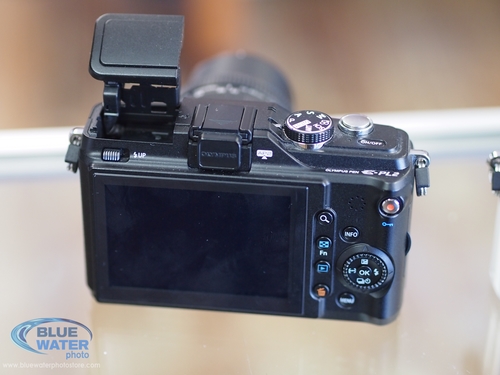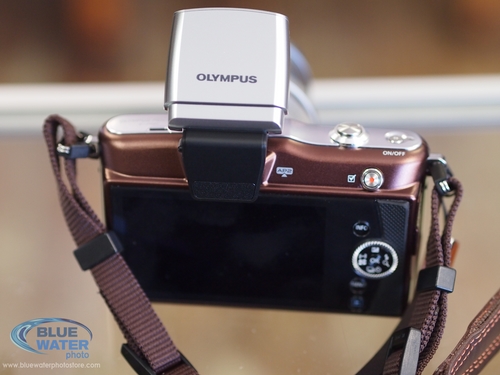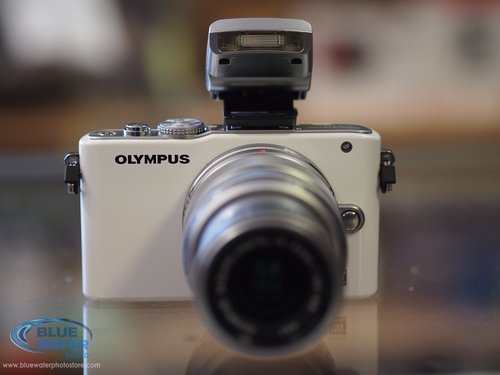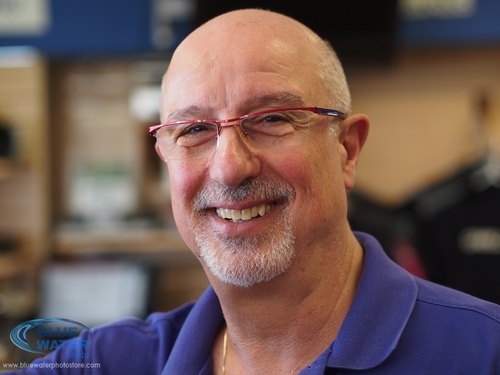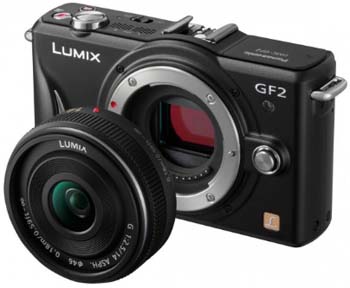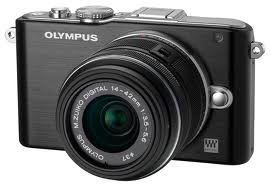
My friendly Olympus rep stopped into Bluewater Photo today, bringing with him some new cameras. Between the two of us, we had 5 different Olympus micro-four thirds models on the counter. You know what means – time for some testing!
I compared the Olympus E-PL2 with two of the new Olympus models, the E-PL3 and the less expensive E-PM1, aka “the Mini”. I also tested out the new Olympus 45mm F1.8 micro-four thirds lens. There is also a more expensive E-PL3, but there is no Olympus underwater housing for it.
Carmen, our friendly Olympus rep. Here are the backs of the Olympus E-PL2, E-PL3 and the E-PM1.
Fronts of the E-PM1, E-PL3 and E-PL2. All are similar in size. The E-PM1 and E-PL3 come with a small external flash that easily slides on top of the camera.
Back of the Olympus E-PL3. It’s similar to the E-PL2 back, with the buttons slightly re-arranged.
Back of the Olympus E-PL2. I find the Olympus cameras quite easy to learn in just a few minutes.
Back of the Olympus E-PM1. The “mini” lacks many buttons, which means you have to use the menu to do things like change modes. But it is cheaper.
Photo taken with the 45mm F1.8 lens. The F1.8 lens produced a nice creamy bokeh in the background. The lens was small, but not tiny, certainly not a “pancake” lens.
Photo taken with the F1.8 lens, my meager attempt to blur the background. The background is blurred, but not as much as it would be with my dSLR.
Camera Differences
The E-PL3 is very similar to the E-PL2. Images taken with both cameras will look the same. The E-PL3 focuses more quickly than the E-PL2, and adds an auto-focus assist light, and a new tilting LCD screen.
Here are the main improvements over the E-PL2:
-
New sensor, claiming better high ISO performance
-
35 auto-focus points instead of 11
-
1080p video instead of 720p
-
Faster shooting speed
-
Faster focusing
-
AF assist light
-
Built-in Flash changed to a removable flash
-
E-PM1 has 3D capability
Olympus E-PL3 specs
-
12 megapixel four-thirds sensor. View sensor sizes here.
-
In-body image stabilization
-
1080p HD video
-
RAW + full manual controls supported
-
35 auto-focus points
-
Sync speed 1/160th
-
max shutter speed 1/4000th
-
capable of 4fps with IS on, 5fps with image stabilization off
-
ISO range 200-12800, but I wouldn’t go over ISO 1600
Handling, size, and weight
All 3 cameras felt about the same size and weight. The E-PM1 was difficult to hold single handedly due to the lack of a good grip. The memory card / battery compartment of the E-PL3 and E-PM1 is a pain to use – E-PL2 users will be longing for the old design for sure.
Focus Speeds
I tested the E-PL2 against the new E-PL3 and E-PM1 in bright light and in low light. In bright light the new models focused significantly faster, it was quite a noticeable improvement. In very low light all models struggled, but with the AF-assist light the E-PL3 and E-PM1 could quickly achieve focus.
Shooting speed – multiple shots
I tested all 3 models in single shot mode, with the flash on a fixed 1/16th power, similar to how the camera might be configured in an underwater housing. I was able to take 5 shots with the newer models, in the time it took to take 3 shots with the E-PL2, it was a noticeable difference.
Macro capability of the 14-42mm kit lens
Olympus has come out with a 3rd version of the 14-42mm kit lens. The first version, which shipped with the E-PL1, could take photos of images as small as 2 inches wide. The 2nd and 3rd versions lost some macro capability, and can take photos only 3 inches wide.
The most recent version of the 14-42mm lens has a silver, almost metal look to it, but it is still a plastic lens.
We tested all 3 lenses with and without the Dyron +7 macro lens, and the results were similar. Using the macro lens gave almost triple the magnification, allowing a photo 1.125 inches across to be photographed. I’d expect similar improvements with the Subsee +5 or +10 diopters.
Testing video
Video performance was similar between all models. The newer models improves the video resolution from 720p to 1080p.
Underwater Housings
Olympus will not be making a housing for the more expensive E-P3. The E-PL3 and E-PM1 housings will be similar to the E-PL1 and E-PL2 housings, but slightly more expensive at $799.95 USD.
The housing costs more than the E-PL2 housing because it comes with a target/focus light built into the port. This is a nice feature which can help improve focusing speeds, although the light is not very strong.
The housing for the E-PL3 is the PT-EP05L housing, and the one for the E-PM1 is the PT-EP06L housing. There is also a Olympus PT-EP06 E-PM1 housing that does not have any lights, which costs $200 less than the EP06L housing. I’d go for the housing without the lights, unless you want to use a wide-angle wet lens, in which case you’ll need the version with the lights because it also has a threaded port. However the version with lights will not support the 60mm macro lens, which is a drawback.
There is also a great Nauticam E-PL3 housing, which is very small and made out of aluminum. Port changing is much easier with this housing. This housing is more expensive though.
Verdict:
The E-PL3 is a nice replacement for the E-PL2. You get faster focusing, although at higher price.
Getting the Olympus E-PM1 saves you up to $200. It is pretty much the same camera, although you need to use the menu instead of controls for changing modes and lose 3 of the buttons. You also lose the flip-LCD.
The E-PL3 is $800 in the USA, the E-PM1 is $600.
Further Reading
Guide to Mirrorless Cameras
Panasonic 8mm fisheye lens review on the Olympus E-PL2
Olympus E-PM1 Underwater Review




